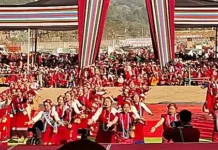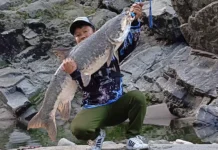[ Taba Ajum ]
Tension between the indigenous Mishmi population and Chakma refugees has surfaced in Kathan in Lohit district. In fact, the tension in the area has been building up over the last decade. In 2011, a team of the AAPSU, led by its then vice president Nabam Tamar and then spokesperson Tobom Dai (who is the present GS of the union) visited the area. A media team had accompanied the AAPSU team. In Kathan, we stayed at the house of Mr Balijan Krisikro, under whose leadership the local people were strongly resisting attempts allegedly being made by Chakmas to encroach on traditional Mishmi land. Mr Krisikro, who went missing under mysterious circumstances in 2020 from Wakro area, is yet to be traced.
One of the main demands he had put before the state government was to provide gun licences to all the local people of Kathan, claiming that they were facing threat to their lives from the refugee settlers. There is no doubt that, over the years, the Chakma-Hajong refugees have moved out of their settlement areas in Namsai, Lohit and Changlang districts. In areas like Diyun and M’Pen, they outnumber the indigenous population. The Singhpos were the first to lose a large chunk of their traditional land to Chakma-Hajong settlers.
Their population is too small and they could not withstand the fury of the settlers. There are also conflicts in certain pockets of Namsai district over land resources between the Khamti community and the settlers.
The Mishmis fear that, starting from Kathan, a systematic attack is being made to capture their land. With their population growing, the Chakmas and the Hajongs are also looking for new lands. The younger generation who were born in Arunachal do not consider themselves refugees. Unlike the older generation, who limited themselves to the refugee settlement areas demarcated by the government, the young generation consider themselves as being indigenous and see it as their birth right to settle anywhere. This is leading to direct conflicts with the indigenous population. Also, the locals of Kathan allege that Chakma settlers first constructed a Buddhist monastery on traditional Mishmi land with the intention to capture. This is the first reported case of the settlers using religion as a tool to encroach on land. This is a new trend and is fraught with danger.
Sadly, the state as well as the central government is neglecting this issue. Only when a situation flares up does the government make some effort to contain the situation. Till date, no sustained effort has been made to amicably resolve the issue.
Also, successive governments at the Centre have been sympathetic towards the Chakma-Hajong refugees, be it the BJP or the Congress. These two communities, who originally hail from Bangladesh, have been big assets for the Indian intelligence communities, especially the R&AW. Further, they have successfully managed to develop a strong lobby at the national and international levels. The human rights bodies often see indigenous Arunachalee tribals as the oppressors and the Chakma-Hajong refugees as the victims. However, this might not turn out to be true if a proper survey is conducted on the ground. There is no doubt that the story of the Chakmas and the Hajongs is also very tragic. They have been victims of violence and had to flee their homeland.
In 2020, the BJP government in the state informed that the combined population of the Chakmas and the Hajongs is 65,875, out of which 5,097 have voting rights. However, it is believed that the actual population is way above the official figure of 65,875.
With population growth, the battle for resources is expected to heat up between the indigenous communities and the refugee settlers in the coming years, with land being at the centre of it. It is not possible to send back the refugee settlers to their place of origin. They also have certain rights which cannot be denied to them. A solution needs to be worked out which is acceptable to all sides. The longer the government neglects this issue, the more it poses a threat to the peace and stability in the state.
Kathan is a new frontline in the conflict between the refugee settlers and the indigenous population over land resources. Unfortunately, the frontline changes every decade. Earlier, it was the Singpho heartland like M’Pen and Diyun. Now, Mishmi and Khamti areas are the new frontlines. Who knows where the next frontline is going to be.




